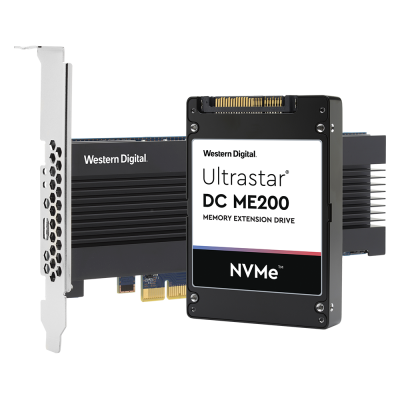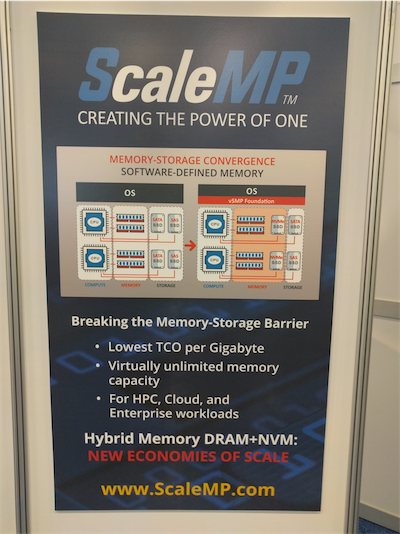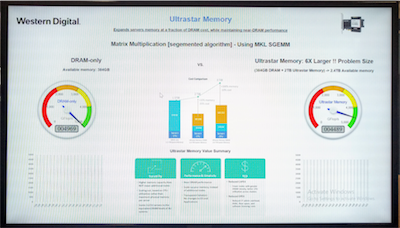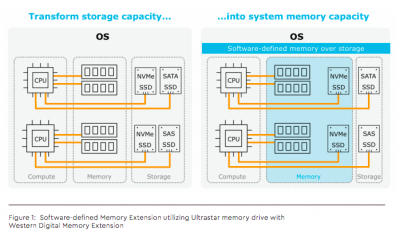Western Digital In-Memory Computing With Ultrastar Memory Drive
DC ME200 memory extension drive expands servers with memory capacity for real-time data processing, scaling databases, application caching and cloud services.
This is a Press Release edited by StorageNewsletter.com on November 13, 2018 at 2:24 pmWestern Digital Corporation is extending the breadth and depth of its data center portfolio into the evolving in-memory computing market segment.

The new Ultrastar DC ME200 Memory Extension Drive is the company’s first product that enables customers to better optimize in-memory system capacity/performance for running demanding applications that drive today’s real-time analytics and business insights.
“Today’s requirement for faster analytics, data processing, cloud services and high-performance computing (HPC) is increasing demand for in-memory computing across a variety of industries, including healthcare, telecommunications and IT, and retail,” said Ashish Nadkarni, group vice president, IDC. “By expanding in-memory capacity, the Ultrastar memory drive helps alleviate the high cost of adding extra DRAM, as well as addresses the physical limitations of available DIMM slots, where scaling is either cost-prohibitive or nearly impossible.”
“As a storage infrastructure leader, we’re constantly innovating and delivering solutions that address new ways of capturing, preserving, accessing and transforming data,” said Mark Grace, senior vice president of devices, Western Digital. “The new Ultrastar memory drive is a natural addition to our world-class data center portfolio, addressing growing customer demand for business acceleration and real-time data processing within in-memory platforms. Leveraging our proven technology leadership, data center expertise and economies of scale, we are providing a new paradigm to in-memory computing relative to the size, scale and cost-effectiveness of the solution.”
The Ultrastar memory drive provides cost-efficient, near-DRAM performance for companies to expand memory pools sizes up to 8X the DRAM capacity, while offering substantial CAPEX and OPEX savings. With larger memory pools, application developers can take advantage of memory-aware performance and capacity optimizations, and expand faster data processing across many applications and workloads. The Ultrastar memory drive is for in-memory applications such as Redis, Memcached, Apache Spark and large-scale databases, providing higher capacities over current storage-class memory products.
The Ultrastar memory drive is drop-in ready and PCIe device compatible with most Intel x86 servers. Available in 1TB, 2TB and 4TB, the solution requires no modifications to the operating system, system hardware, firmware or application stacks. For expandability, a 1U server can typically support up to 24TB of system memory using the Ultrastar DC ME200 drive for in-memory compute clusters.
Supported server interfaces are NVMe U.2 and PCIe AIC (add-in-card) HH-HL. Additional product information can be found here.
The Ultrastar memory drive is currently available and sampling with select customers.
Resource:
Western Digital Blog: In-Memory Computing – Lifting the Constraints of Scale
Western Digital at Supercomputing 2018
Western Digital will be showcasing its range of solutions for HPC, cloud and analytics at Supercomputing 2018, including its new Ultrastar memory drive, its family of Ultrastar enterprise-class HDDs and SSDs as well at its ActiveScale and IntelliFlash systems, and its OpenFlex and Ultrastar platforms.
Comments
Last January during the SNIA Persistent Memory Summit 2018, Zvonimir Bandic, senior director research and development engineering at Western Digital, delivered an interesting keynote that shared the company vision and finally a portion of its strategic plan.
In a nutshell, this session was about exascale data center full of Persistent Memory with Fabrics we should see in the future.
To define persistent memory, he (re)defined the approach saying that at component level, this memory must be byte-addressable and non-volatile, deliver latency comparable to DRAM, but have density and cost that falls somewhere between DRAM and NAND flash. He has insisted on the need of a memory fabric to build large persistent memory scale-out farms and conclude that RDMA today is the right approach to build memory fabric even if the industry needs protocols innovations to fulfill latency, throughput and RAS requirements.
The presentation is available here and the video of the talk here.
With the announcement of the Ultrastar DC ME200 Memory Extension Drive (wow it's a bit long), we realize that Western Digital delivers the first phase of that global strategy offering the local aspect of it, I mean a drive.
This idea of this software-defined memory is to expand DRAM with NAND.
The ME200 is a NVMe 2.5-inch U.2 or PCIe AIC HH-HL SSD available in 1TB, 2TB or 4TB coupled into the system thanks to a software layer. This software element does the magic to blend the DRAM and the NAND to build a larger memory space seen by the OS as one piece. As you read, this approach doesn't offer yet any SCM but we anticipate that the company should go in that direction in the coming quarters.
As memory is quite expensive and is limited in a server chassis, the scale-out approach was an answer to that limitation. If the need of CPU is not a constraint, the number of chassis can be reduced to offer a denser server with a mixed of DRAM and NAND-based memory. Western Digital recommends a ratio 1:8 in capacity between DRAM and NAND. For instance instead of having 1TB of DRAM, you can have 128GB of DRAM + 1TB ME200. The TCO is obviously reduced and the performance is still good delivering 80%+ of a full DRAM configuration (I invite the reader to check the various use cases and tests to check the precise numbers).
This approach targets in-memory and demanding applications with solutions like Redis, GridGain, Hazelcast, Apache Ignite and Spark, Aerospike, memcached, MySQL, AI/ML processing or GPU databases.
Click to enlarge
We were intrigued by the magic behind this as the key element is the software that 'blends' DRAM and NAND. Western Digital refused to tell us the name of the third-party vendor so we made basic investigations and found very rapidly the solution. We invite you to check the image below taken from the Western Digital data sheet.
And the photo of the poster we took on ScaleMP booth.

I’m sure you get the similarities I should say the exact matching between the two inviting me to conclude that this magic software comes from ScaleMP with vSMP MemoryONE. And if you add other elements I saw during the day, the mystery is over.
This announcement is important for the storage industry. The battle is on and we expect to see some reactions from other vendors pretty soon. Recently NetApp has demonstrated MAXdata during its conference three weeks ago, result of the acquisition of Plexistor in May 2017. We’ll see for others but 2019 will be interesting.
















 Subscribe to our free daily newsletter
Subscribe to our free daily newsletter

